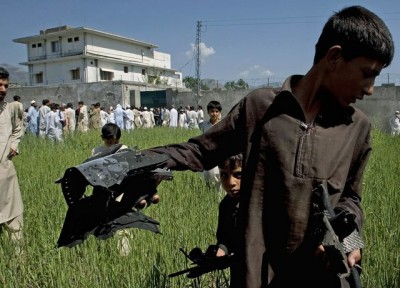The covert operation that killed Osama bin Laden produced new evidence that the “emir” of al Qaeda actively commanded the terror group’s affiliates in Yemen, Somalia and other parts of North Africa and was not just an inspirational leader.

The commandos who carried out the raid also found equipment for use with a multimedia studio where the al Qaeda leader likely recorded some of the audio and video messages he periodically made public over the past nine years as well as compact discs and paper documents, according to these officials.
The officials said investigators already uncovered new leads on the location of other senior al Qaeda leaders, including Ayman al-Zawahri, the Egyptian-born deputy to bin Laden who is the likely successor over al Qaeda.
The CIA has not begun a formal exploitation of the documents and other material found in the raid, but more details are emerging on one of the most successful counterterrorism operations in U.S. history.
One U.S. intelligence official who asked not to be named said “a peripheral scan of the data suggests that he provided strategic guidance and direction to al Qaeda’s affiliates. We knew he had contact with the affiliates through couriers, but the evidence we have now is that he delivered the strategic direction to many of these groups.”
U.S. intelligence analysts for at least two years have said bin Laden exercised strategic control over al Qaeda and its affiliates. As with most intelligence work, however, there were uncertainties.
The idea that bin Laden was a central figure in the command structure of the several al Qaeda affiliates remains controversial among specialists on al Qaeda.
Marc Sageman, a leading counterterrorism academic and former CIA analyst, has written that al Qaeda functions as a leaderless terrorist group and that bin Laden was mainly an inspirational leader of the group.
White House Press Secretary Jay Carney said Tuesday the United States will be looking for three key pieces of intelligence from the material collected.
“First of all and most importantly in any case is any evidence of planned attacks,” he said. “Second would be information that could lead to other high-value targets or other networks that exist that maybe we don’t know about or that we only know a little bit about. And then, you know, third and more broadly, on the al Qaeda network itself and in the sustaining network for bin Laden in Pakistan – what allowed him to live in that compound for as long as he did.”
A U.S. official who asked not to be named said bin Laden gave broad orders to al Qaeda affiliates, such as orders to al Qaeda in the Arabian Peninsula, to attack the continental United States. He also said bin Laden received payments from al Qaeda’s affiliates and approved mergers of affiliates.
Mary Habeck, an expert on al Qaeda at the Johns Hopkins University School of Advanced International Studies, said bin Laden moved to the Abbottabad compound to take charge of the affiliates that were forming in 2005 and 2006.
“I absolutely am convinced the reason he moved there in 2005 and 2006 is that he needed to take closer control of his globalized Jihad,” she said. “This is precisely at the time when the affiliates are being created. This is precisely at the time when Iraq is becoming more and more al Qaeda’s war. It is precisely the moment when the war in Afghanistan is about to take off.”
Ms. Habeck, a strategic planner for the National Security Council during the George W. Bush administration, said: “I envision bin Laden’s role in operations as similar to the secretary of defense,” a leader who does not direct every soldier’s activity but provides overall direction and command.
Rep. Mike Rogers, Michigan Republican and chairman of the House Permanent Select Committee on Intelligence, on Tuesday called bin Laden an “inspirational and operational leader.”
When asked about the future of the U.S. fight against al Qaeda Mr. Rogers told CNN: “We still have Zawahri, the number two, who is likely to ascend to the number one position in al Qaeda. We still have a very strong al Qaeda network that is striving to not only survive but grow and develop in different parts of the world: Yemen, Somalia and other places. So our work isn’t done.”
On Tuesday, senior U.S. officials provided additional details on the raid and the fact that Pakistan’s government and military were kept out of the planning and execution.
CIA Director Leon Panetta said in an interview with NBC that “the Pakistanis did not know anything about this mission.”
Mr. Panetta noted that the secrecy “was deliberate on our part [so] that this would be conducted as a unilateral mission. President Obama had made very clear to the Pakistanis that if we had good evidence as to where Osama bin Laden was located, we were going to go in and get him. And – that’s exactly what happened.”

Leave a Reply
You must be logged in to post a comment.